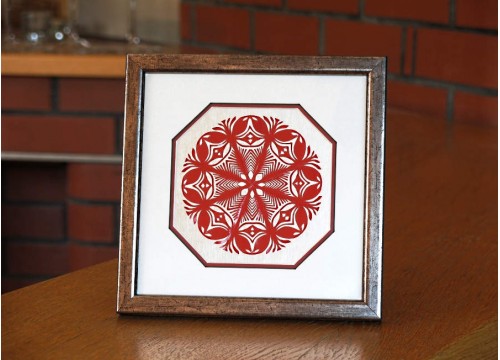
| You have no items in your shopping cart |
Transportation cost: Poland: 14 - 16 zł, Worldwide: from 22 zł

| You have no items in your shopping cart |
This is a hand-made and beautifully framed traditional Kurpie paper cutting. This paper cutting is a typical example of a classical Kurpie 'leluja'. It is a single-coloured paper cutting elaborated along a single symmetrical axis. It is composed in a characteristic way for this form of a paper cutting – its lower part is smaller and less decorated, the upper part is open-worked and richly adorned. ‘Leluja’ presents a tree of life on whose top a couple of doves are perched – their beaks meet. Two cocks stand at the tree trunk at the bottom of the paper cutting. The paper cutting is made from intensively coloured red paper. It is presented against a yellow background showing a distinct contrast which allows to bring out the precision of cutting and accentuates an interesting shape of the paper cutting. Special attention should be drawn to a very elaborate and artistic paper cutting frame which was individually chosen by a professional framing studio. The frame is made from dark brown wood with a clearly visible structure of rings. The pastel purple passé-partout complements the entire composition. A pane protects the paper cutting against destruction. The frame is equipped with a loop which enables it to be hung.
A paper cutting – in other words – a coloured picture made of paper came about thanks to intricate cutting and it represents the most characteristic element of the Polish folk art. Nowhere else – outside of Poland - can such a great variety of paper cuttings be found. The paper cutting art developed in the XIXth century mainly in central and eastern Poland as one of the most important forms of room decorating. It was most probably inspired by stars glued onto windows in Jewish rooms. Women used to cut them out from paper bough from door-to-door salesmen. They drew inspiration from nature and their imagination. What is interesting – paper cuttings were made spontaneously without a formerly sketched pattern. Formerly they were cut out with scissors used for sheep shearing. Holding scissors at the blades artists took advantage of scissors’ resilient energy. In the east a paper cutting is represented mostly by the Kurpie region paper cutting. It is single-coloured – the most important element is its shape. One of the most popular forms are Kurpie region stars. These beautiful openwork, single-coloured compositions – are cut out extremely finely and often along the 8 or even 12 axis format. It proves that one must have great imagination in order to create such a beautiful and harmonious pattern seeing solely its small fragment. Kurpie region stars were used as adornments of side walls, beams and ceilings. Nowadays equally impressive compositions are created that splendidly blend into the modern interior. Another popular paper cutting in the east is Leluja. It symbolizes a tree of life. It is a single-coloured, symmetrical and vertical paper cutting with one symmetrical axis format. It is most often composed of two joint parts – a lower one which is smaller and less openwork-shaped; and an upper one which is lavishly adorned.
Mrs Czesława from Dylewo is one of the most renowned Kurpie region artists. For nearly 40 years she has been occupying herself with paper cuttings, embroidery, weaving, solo singing, interior decoration, ritual visual arts, as well as ritual baking. She learnt the paper cutting art from her grandmother – Mrs Antonina from Strzałki. In her works of art she preserves the traditional forms of Kurpie region paper cuttings such as: ‘leluja’, stars, silhouette paper cuttings (ponies and birds). Mrs Czesława has achieved an individual style and exceptional expression of her works due to the use of a large format and an introduction of her own pattern elements. She is a laureate of numerous regional and nationwide competitions. Her works of art brought her several awards, among others a Ministry of Culture and Art recognition certificate, the Ostrołęka Province Governor award, as well as Mazowieckie Province Marshal in 2001, Knight of the Polonia Restituta Order, and in 2005 she was a laureate of Oscar Kohlberg award for ‘merits for folk culture’. Mrs Czesława is actively involved in the Kurpie region folk art development. Her numerous social functions cover such roles as: chairperson of Kurpie Region Affiliate of Folk Artists and work in Kurpie Region Association, as well as Kurpie Culture Museum Council in Ostrołęka. Mrs Czesława displays her works of art during folk art trades and bazaars in Poland and abroad: in Austria, Denmark, Sweden, Tunisia, Italy and Germany. She strives to pass her passion and experience onto a younger generation by lecturing in museums and schools and running handicraft courses.
No customer reviews for the moment.















